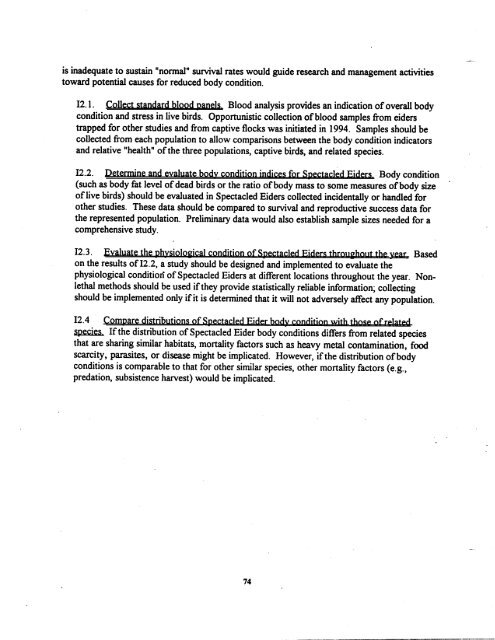A. Status of the Spectacled Eider - U.S. Fish and Wildlife Service
A. Status of the Spectacled Eider - U.S. Fish and Wildlife Service
A. Status of the Spectacled Eider - U.S. Fish and Wildlife Service
You also want an ePaper? Increase the reach of your titles
YUMPU automatically turns print PDFs into web optimized ePapers that Google loves.
is inadequate to sustain “normal” survival rates would guide research <strong>and</strong> management activities<br />
toward potential causes for reduced body condition.<br />
12.1. Collect st<strong>and</strong>ard blood panels. Blood analysis provides an indication <strong>of</strong>overall body<br />
condition <strong>and</strong> stress in live birds. Opportunistic collection <strong>of</strong>blood samples from eiders<br />
trapped for o<strong>the</strong>r studies <strong>and</strong> from captive flocks was initiated in 1994. Samples should be<br />
collected from each population to allow comparisons between <strong>the</strong> body condition indicators<br />
<strong>and</strong> relative “health” <strong>of</strong><strong>the</strong> three populations, captive birds, <strong>and</strong> related species.<br />
12.2. Determine <strong>and</strong> evaluate body condition indices for <strong>Spectacled</strong> <strong>Eider</strong>s. Body condition<br />
(such as body fat level <strong>of</strong>dead birds or <strong>the</strong> ratio <strong>of</strong>body mass to some measures <strong>of</strong>body size<br />
<strong>of</strong>live birds) should be evaluated in <strong>Spectacled</strong> <strong>Eider</strong>s collected incidentally or h<strong>and</strong>led for<br />
o<strong>the</strong>r studies. These data should be compared to survival <strong>and</strong> reproductive success data for<br />
<strong>the</strong> represented population. Preliminary data would also establish sample sizes needed for a<br />
comprehensive study.<br />
12.3. Evaluate <strong>the</strong> physiological condition <strong>of</strong><strong>Spectacled</strong> <strong>Eider</strong>s throughout <strong>the</strong> year. Based<br />
on <strong>the</strong> results <strong>of</strong>12.2, a study should be designed <strong>and</strong> implemented to evaluate <strong>the</strong><br />
physiological condition <strong>of</strong> <strong>Spectacled</strong> <strong>Eider</strong>s at different locations throughout <strong>the</strong> year. Nonlethal<br />
methods should be used if <strong>the</strong>y provide statistically reliable information; collecting<br />
should be implemented only ifit is determined that it will not adversely affect any population.<br />
12.4 Compare distributions <strong>of</strong><strong>Spectacled</strong> <strong>Eider</strong> body condition with those <strong>of</strong>related<br />
sp~i~a. If<strong>the</strong> distribution <strong>of</strong><strong>Spectacled</strong> <strong>Eider</strong> body conditions differs from related species<br />
that are sharing similar habitats, mortality factors such as heavy metal contamination, food<br />
scarcity, parasites, or disease might be implicated. However, if<strong>the</strong> distribution <strong>of</strong>body<br />
conditions is comparable to that for o<strong>the</strong>r similar species, o<strong>the</strong>r mortality factors (e.g.,<br />
predation, subsistence harvest) would be implicated.<br />
74

















